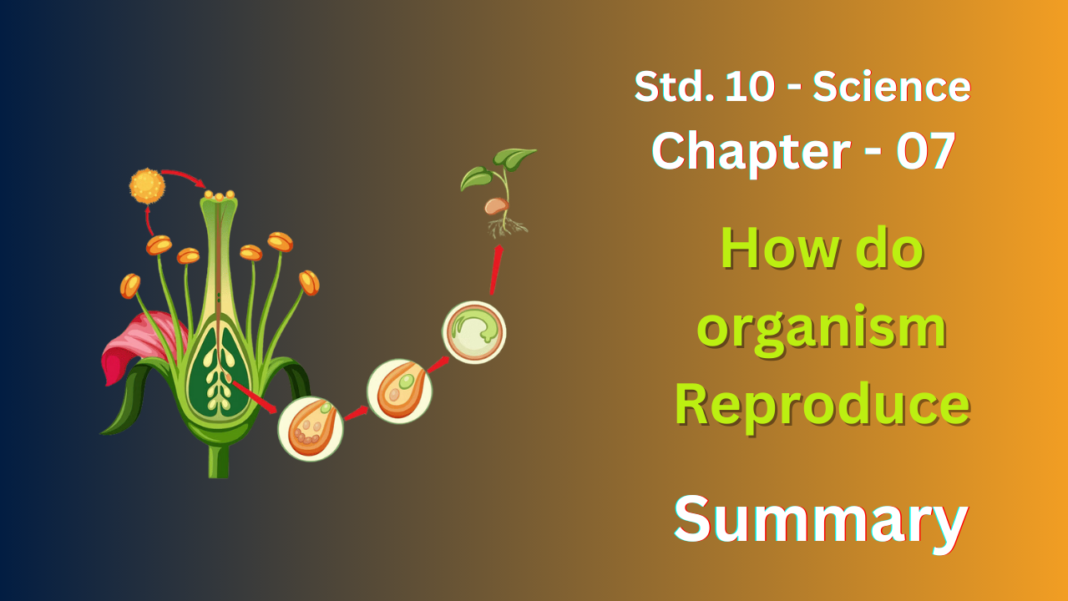This chapter explores the two main ways organisms reproduce:
1. Asexual Reproduction:
- Involves only one parent.
- No formation and fusion of gametes (sex cells) occurs.
- Offspring are genetically identical to the parent.
Types of Asexual Reproduction:
- Fission: Parent splits into two or more individuals (e.g., amoeba).
- Budding: New individual grows from an outgrowth of the parent (e.g., yeast).
- Vegetative propagation: New plants grow from vegetative parts like roots, stems, or leaves (e.g., potato).
- Fragmentation: Parent breaks into pieces, each piece developing into a new individual (e.g., starfish).
Advantages of Asexual Reproduction:
- Faster and simpler than sexual reproduction.
- Allows rapid population growth in favorable conditions.
Disadvantages of Asexual Reproduction:
- Offspring lack genetic variation, making them less adaptable to changing environments.
2. Sexual Reproduction:
- Involves two parents (male and female).
- Requires formation and fusion of gametes (sperm and egg).
- Offspring inherit genetic information from both parents, leading to variation.
Process of Sexual Reproduction in Plants:
- Pollination: Transfer of pollen grains (male gametes) to the stigma (female reproductive part) of a flower.
- Fertilization: Fusion of sperm (from pollen) with egg (in ovule).
- Seed formation: Fertilized ovule develops into a seed containing an embryo (new plant).
- Fruit formation: Ovary ripens into a fruit, aiding seed dispersal.
Process of Sexual Reproduction in Animals:
- Internal fertilization (sperm meets egg inside the female) or external fertilization (sperm meets egg in water).
- Development of embryo: Fertilized egg divides and grows into an embryo.
- Different development patterns depending on the animal group (oviparous – lays eggs, viviparous – gives birth to live young).
Advantages of Sexual Reproduction:
- Creates offspring with genetic variation, allowing for adaptation and evolution.
Disadvantages of Sexual Reproduction:
- Requires two parents and can be slower than asexual reproduction.
Questions (Page 114)
1. What is the importance of DNA copying in reproduction?
Ans :
- Preserves traits: Ensures offspring inherit characteristics from parents (asexual reproduction).
- Enables variation: Allows for mutations during copying in sexual reproduction, providing the raw material for evolution.
Overall, DNA copying is crucial for both transmitting essential information and introducing the possibility of change in reproduction.
2. Why is variation beneficial to the species but not necessarily for the individual?
Ans : Variation is like a species’ toolbox. It helps the species adapt to changing environments (e.g., new food source) by providing a wider range of traits. However, not all variations benefit the individual. An individual with a trait not suited to the current environment might struggle to survive (e.g., poor eyesight in the dark). So, variation is good for the species’ survival, but not guaranteed for any single organism.
Questions (Page 119)
1. How is the process of pollination different from fertilisation ?
Ans :
| Feature | Pollination | Fertilization |
| Definition | Transfer of pollen grains (male gametes) | Fusion of sperm (from pollen) with egg (in ovule) |
| Process | Pollen grains travel from anther to stigma (via wind, animals, etc.) | Pollen grain germinates, pollen tube grows to ovule, sperm fertilizes egg |
| Result | Pollen lands on stigma, but no fertilization yet | Formation of a zygote (fertilized egg) |
| Analogy | Handshake (pollen transfer) | Marriage (sperm & egg unite) |
2. How will an organism be benefited if it reproduces through spores ?
Ans :
Travel far: Tiny and light, spores hitch rides on wind, water, or animals to find new homes.
Pop! Spores are produced in massive numbers, increasing the chance some will find suitable conditions to grow.
Wait it out: Spores can lie dormant for long periods, waiting for harsh conditions to pass.
Simple process: Spore formation is quick and easy, no fancy partner needed.
Variation bonus (sometimes): Some spores have a touch of variety in their genes, helpful for adapting to change.
3. Can you think of reasons why more complex organisms cannot give rise to new individuals through regeneration ?
Ans :
Specialized Cells: Cells are stuck to their jobs (skin makes skin, not hearts!).
Too Complex: Organs work together like a symphony – regrowing everything is a logistical nightmare.
Limited Cell Growth: Adult cells often take a permanent vacation from dividing, making it hard to build a whole new you.
Missing Instructions: The “how-to” guide for building an adult is lost in adulthood.
Energy Drain: Growing a whole body is expensive – complex organisms might not have the funds.
Evolutionary Choice: Maybe regeneration just wasn’t as important for complex organisms to survive and reproduce.
4. Why is vegetative propagation practised for growing some types of plants ?
Ans : Plants that don’t produce seeds or have unreliable seeds are often grown using vegetative propagation
5. Why is DNA copying an essential part of the process of reproduction ?
Ans : DNA copying, also known as DNA replication, is fundamental to reproduction for two key reasons:
- Preserving Hereditary Information: DNA is the blueprint of life, containing the instructions for building and maintaining an organism. During reproduction, DNA copying ensures an exact replica of this blueprint is passed on to the offspring. This allows for the inheritance of traits and characteristics from parents to their children.
- Enabling Variation (Sexual Reproduction): In sexual reproduction, DNA from two parents combines. While DNA copying ensures each parent’s DNA is accurately copied, the process isn’t perfect. Occasionally, slight errors or mutations can occur during copying. These mutations, although sometimes harmful, can also introduce new variations in the offspring’s DNA.
Questions (Page 126)
1. How is the process of pollination different from fertilisation ?
Ans :
| Feature | Pollination | Fertilization |
| Definition | Transfer of pollen grains (male gametes) | Fusion of sperm (from pollen) with egg (in ovule) |
| Process | Pollen grains travel from anther to stigma (wind, animals) | Pollen grain germinates, pollen tube grows to ovule, sperm fertilizes egg |
| Result | Pollen lands on stigma, but no fertilization yet | Formation of a zygote (fertilized egg) |
| Analogy | Handshake (pollen transfer) | Marriage (sperm & egg unite) |
2. What is the role of the seminal vesicles and the prostate gland ?
Ans : Seminal vesicles and the prostate gland are teamwork players in the male reproductive system:
- Seminal Vesicles: The “energy drink guys” – their fluid provides sugar and nutrients for sperm to swim strong.
- Prostate Gland: The “path smoother guy” – their fluid thins semen and might help sperm pass through the cervix.
3. What are the changes seen in girls at the time of puberty ?
Ans :
Boobs develop: Lumps appear under the nipples, followed by growth (may be tender).
Body transformation: Hips widen, curves appear, fat increases in breasts, thighs, and butt.
Taller and heavier: A growth spurt leads to height and weight gain.
Hair down there: Fine, soft hair appears around the genitals, becoming darker and coarser later.
Periods start: The body releases eggs, uterus lining thickens, then sheds if no pregnancy (period!). Periods might be irregular at first.
Other fun stuff: Oily skin, acne, more sweating, body odor, vaginal discharge (all normal!).
Emotions and social changes: Mood swings, self-consciousness, body image concerns are common. Girls might be more interested in relationships and figuring out who they are.
4. How does the embryo get nourishment inside the mother’s body ?
Ans : The embryo, and later the fetus, receives nourishment inside the mother’s body through a fascinating organ called the placenta.
The placenta acts as a lifeline, providing vital nutrients and oxygen to the developing embryo while removing waste products. It’s a remarkable example of adaptation that ensures the survival and growth of the baby inside the mother’s womb.
5. A woman is using a copper-T. Will it help in protecting her from sexually transmitted diseases ?
Ans : No, a copper-T, also known as an intrauterine device (IUD), does not protect against sexually transmitted diseases (STDs).
Copper IUDs are very effective at preventing pregnancy, but they don’t create a barrier to block the transfer of bodily fluids during sex. This means STDs like HIV, HPV, chlamydia, gonorrhea, and syphilis can still be transmitted.
Exercises
1. Asexual reproduction takes place through budding in
(a) amoeba
(b) yeast
(c) plasmodium
(d) leishmania
Ans : (b) yeast
2. Which of the following is not a part of the female reproductive system in human beings ?
(a) Ovary
(b) Uterus
(c) Vas deferens
(d) Fallopian tube
Ans : (c) Vas deferens
3. The anther contains
(a) sepals
(b) ovules
(c) carpel
(d) pollen grains
Ans : (d) pollen grains
4. What are the advantages of sexual reproduction over asexual reproduction ?
Ans :
Increased Variation:
- Mixing Genes: During sexual reproduction, genetic information from two parents combines, creating offspring with a unique blend of traits. This variation is essential for:
- Adaptability: Populations with more variation are better equipped to adapt to changing environments. Individuals with beneficial traits due to genetic variation have a higher chance of survival and reproduction in a new environment.
- Evolution: Over generations, sexual reproduction allows for the accumulation of beneficial mutations, leading to the evolution of new species.
Reduced Risk of Harmful Mutations:
- Asexual reproduction relies on copying the parent’s DNA. Over time, copying errors can accumulate, potentially leading to harmful mutations. Sexual reproduction allows for the “reshuffling” of genes, potentially diluting or eliminating the negative effects of some mutations.
Faster Repair Mechanisms:
- Sexual reproduction can sometimes trigger DNA repair mechanisms when genetic mismatches occur during the mixing of parental genes. This can help maintain the integrity of the genetic code and reduce the risk of harmful mutations being passed on.
5. What are the functions performed by the testis in human beings ?
Ans :
- Sperm Production (Spermatogenesis):
- The primary function of the testes is to produce sperm cells, the male gametes necessary for fertilization.
- Within the testes are tiny seminiferous tubules where sperm production (spermatogenesis) occurs.
- Spermatogenesis is a complex process that starts with immature germ cells and goes through several stages of cell division and differentiation to form mature sperm cells.
- Testosterone Production:
- The testes also produce the primary male sex hormone, testosterone.
- Leydig cells, located between the seminiferous tubules, are responsible for testosterone production.
- Testosterone is essential for several functions in males, including:
- Development and maintenance of male secondary sexual characteristics like facial hair, deeper voice, and muscle mass.
- Stimulating sperm production.
- Regulating bone growth and muscle development.
- Sex drive (libido).
- Production of red blood cells.
6. Why does menstruation occur ?
Ans :Menstruation occurs due to the hormonal changes happening within a female body that is not pregnant.
The Monthly Cycle: The female reproductive system operates on a hormonal cycle, typically around 28 days. Estrogen and progesterone are the key players.
Preparing for Pregnancy: Estrogen thickens the lining of the uterus (endometrium) each month in preparation for a possible pregnancy. This lining is rich in blood vessels and nutrients to support a developing embryo.
No Fertilization: If fertilization (sperm meeting egg) doesn’t occur, the levels of estrogen and progesterone drop significantly.
Shedding the Lining: Without the hormonal support, the thickened uterine lining no longer needed is shed. This shedding, along with some blood, exits the body through the vagina as a menstrual period.
The Cycle Starts Anew: After menstruation, the hormone levels begin to rise again, initiating the process of preparing the lining for the next potential pregnancy.
7. Draw a labelled diagram of the longitudinal section of a flower.
Ans :
8. What are the different methods of contraception ?
Ans :
Hormonal: Pills, patches, rings, shots, IUDs (some hormonal) – very effective, regulate hormones.
Barrier: Condoms (male & female), diaphragms, spermicide – physical block for sperm, condoms also prevent STIs.
Natural Family Planning: Track your cycle to avoid fertile times – less effective, requires discipline.
Sterilization: Surgery (female – blocks tubes, male – blocks sperm path) – permanent solution.
Emergency: “Morning-After Pill” – high dose hormones for emergencies, not as effective as regular methods.
9. How are the modes for reproduction different in unicellular and multicellular organisms ?
Ans :
| Feature | Unicellular Organisms | Multicellular Organisms |
| Dominant Mode | Asexual reproduction | Sexual reproduction |
| Examples of Asexual Reproduction | Binary fission, budding, fragmentation | Vegetative propagation (plants), some specific cases in animals |
| Process | Simple cell division | Involves specialized reproductive organs and gamete fusion |
| Offspring | Genetically identical to parent | Genetically varied |
| Benefits | Fast, efficient for rapid growth | Allows for adaptation and evolution |
| Drawbacks | Limited variation | Requires finding a mate, slower process |
| Analogy | Single-person bakery using a simple recipe for identical products | Large bakery team using complex methods for varied products |
10. How does reproduction help in providing stability to populations of species ?
Ans : Reproduction keeps populations stable in two ways:
- Newborn Replacements: Birth (or hatching) fills the gaps left by deaths, keeping the population from shrinking.
- Mix & Match Genes: Sexual reproduction shuffles genes, creating variety. This helps populations adapt to a changing world, like a new disease or climate.
11. What could be the reasons for adopting contraceptive methods ?
Ans :
Preventing Pregnancy: This is the primary reason for using contraception. People might choose to delay parenthood entirely, space out children they already have, or avoid pregnancy for other reasons.
Controlling Family Size: Contraception allows couples to plan the number of children they want to have and the spacing between them.
Reducing Health Risks: In some cases, pregnancy can pose health risks for the mother. Contraception can help avoid unintended pregnancies that could be detrimental.
Promoting Sexual Health: Condoms, for example, can help prevent the spread of sexually transmitted infections (STIs).
Managing Medical Conditions: Some hormonal contraceptives can help regulate menstrual cycles, reduce menstrual cramps, or manage certain medical conditions like PCOS.









